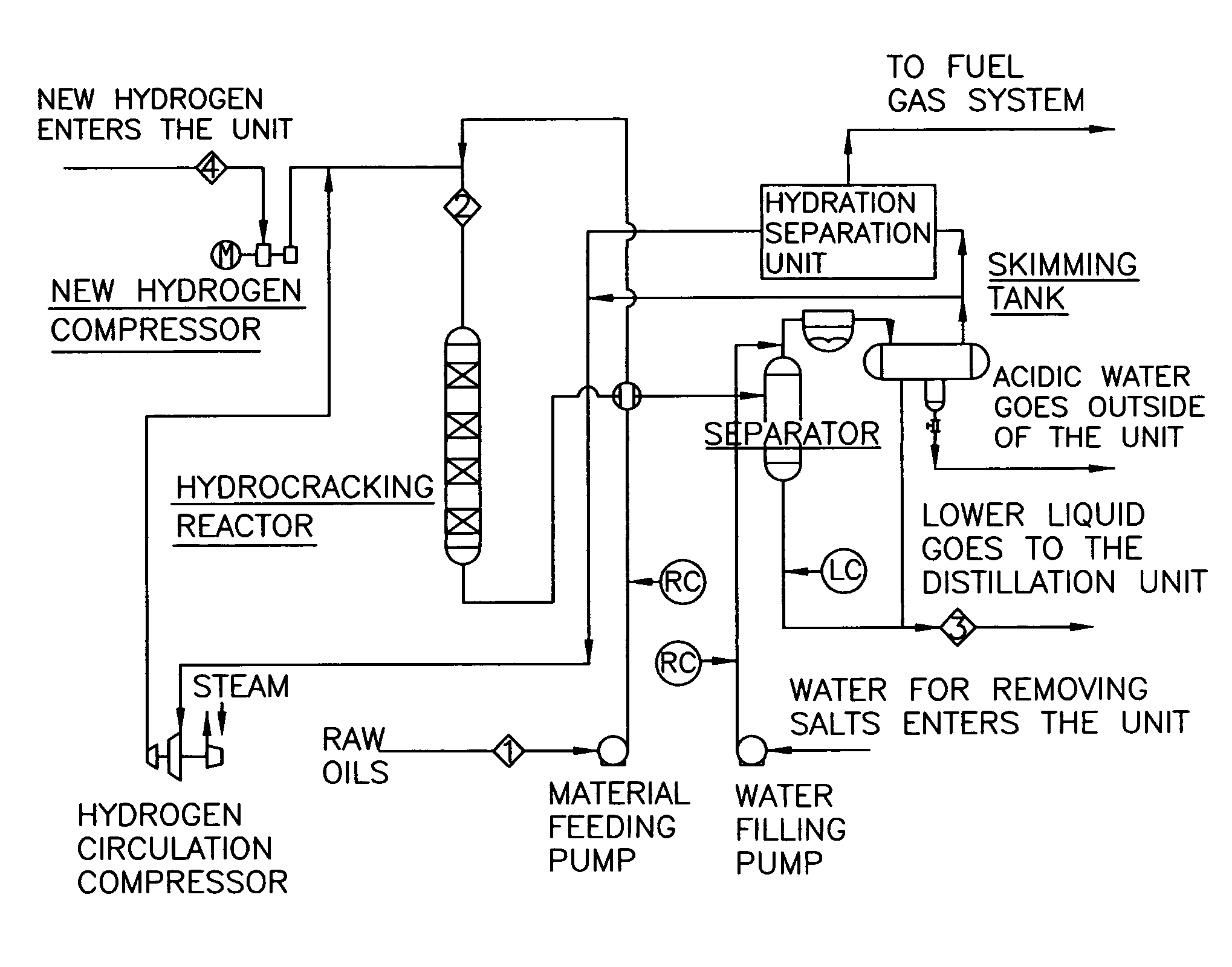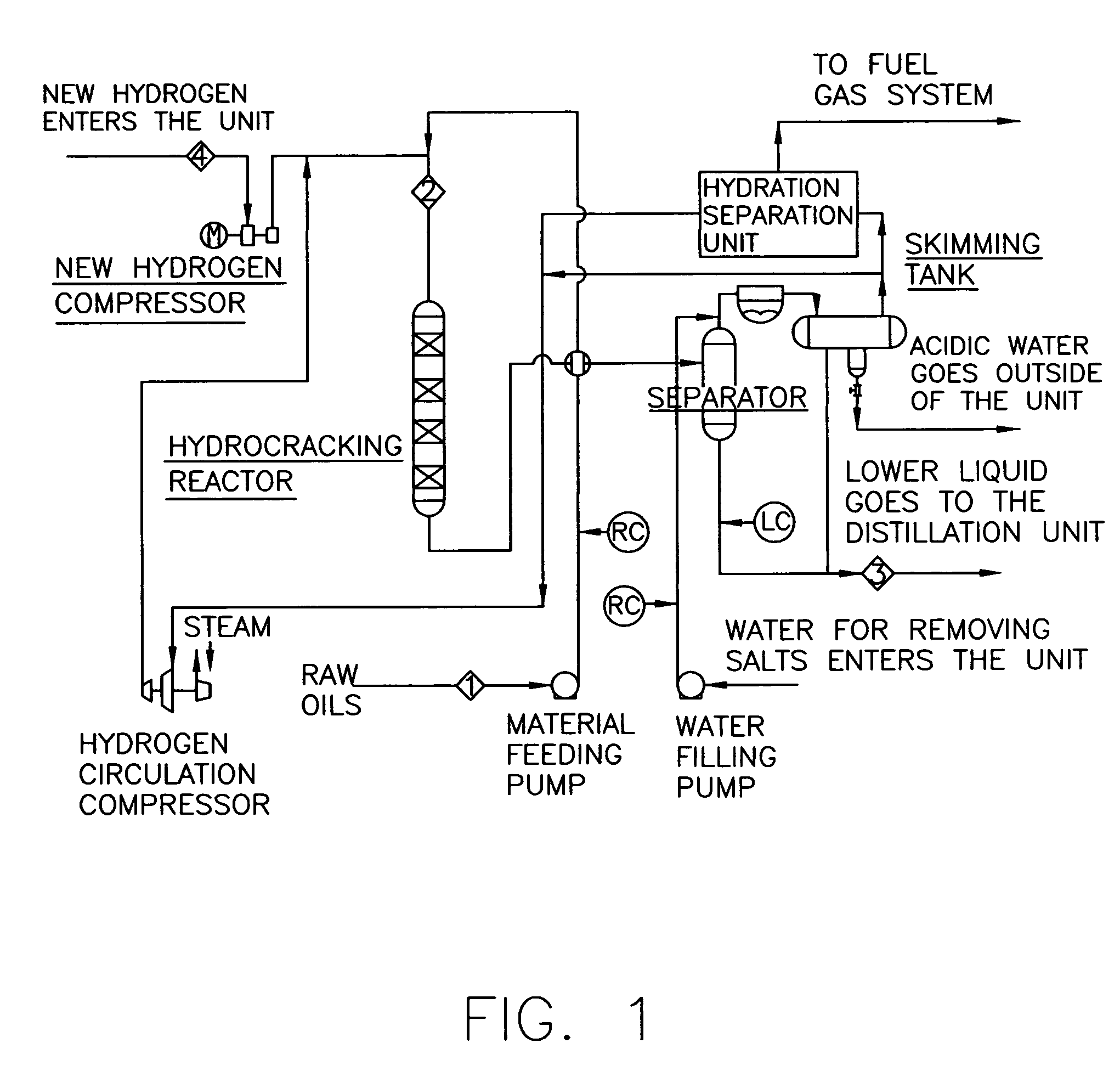Apparatus and method for increasing the concentration of recycled hydrogen in a high pressure hydrogenation reactor
a technology of high-pressure hydrogenation and apparatus, which is applied in the direction of hydrogen separation, effluent separation, separation processes, etc., can solve the problems of reducing the equipment investment of the whole reaction system comprising reactor(s), reducing the purity of recycle hydrogen, and reducing the total reacting pressure. , to achieve the effect of reducing the pressure of concentration-increased hydrogen, reducing the total reacting pressure, and high pressur
- Summary
- Abstract
- Description
- Claims
- Application Information
AI Technical Summary
Benefits of technology
Problems solved by technology
Method used
Image
Examples
example 1
[0056]Between a high-pressure separator and a hydrocracking reactor a hydration separation unit comprising a hydration reactor 1 and a hydrate decomposer 3 was included. The hydration reactor 1 was constructed with the combination of a mist spray and sieve plates. The upper part of the reactor was the mist spray area equipped with sprayers 13 and a set of serpentine cooling pipes 9. The lower part of the reactor was the sieve plates area equipped with sieve plates 10. The internal upper part of the hydrate decomposer 3 was equipped with wire mesh demisters 15. A high pressure separator was connected with the inlet 11 of raw gases at the lower part of the sieve plates area of the hydration reactor via heat exchanger 4; the outlet 12 of hydrate slurry at the bottom of the hydration reactor was connected with the inlet 17 of hydrate slurry of the hydrate decomposer via heat exchanger 2; the outlet 7 of hydrogen with high concentration (rich hydrogen) at the top of the hydration reactor...
example 2
[0058]The same equipments are employed as in example 1 except that
[0059]The composition of raw gases entering into the hydration separation unit (equivalent to the gases from the high pressure separator) was: H2 (93 mol %)+CH4(5 mol %)+C2H6 (2 mol %). The operating temperature of the hydration reactor was 1-5° C. with 18 MPa of the operating pressure. The water-in-oil microemulsion was prepared with 3 volumes of water solution in which the mass concentration of tetrahydrofuran was 21% by mass and 7 volumes of diesel, the microemulsion / gas flux ratio was 1 / 100 (standard V / V), and the gases stayed in the reactor for 18 minutes. After the concentration of hydrogen was increased, the gases contained H2 (97.5 mol %)+CH4(2.2 mol %)+C2H6(0.3 mol %). The concentration of hydrogen in the mixture of concentration-increased gases and raw gases (mixed in the volume ratio of 1:1) showed 95.2%, indicating that of the gases coming from the high pressure separator, mixing of 50% which had experienc...
example 3
[0060]The same equipments are employed as those in example 1 except that:
[0061]The composition of raw gases entering into the hydration separation unit (equivalent to the gases from the high pressure separator) was: H2 (90 mol %)+CH4(7 mol %)+C2H6 (3 mol %). The operating temperature of the hydration reactor was 1-5° C., the operating pressure was 15 MPa, the water-in-oil microemulsion was prepared with 3 volumes of water solution in which the mass concentration of tetrahydrofuran was 21% by mass and 7 volumes of diesel, the microemulsion / gas flux ratio was 1 / 100 (standard V / V), and the gases were kept in the reactor for 18 minutes. After the concentration of hydrogen was increased, the gases contained: H2 (97.0 mol %)+CH4(2.5 mol %)+C2H6(0.5 mol %). The concentration of hydrogen in the mixed gases of concentration-increased gases and raw gases (mixed in the volume ratio of 5:2) was 95.0%, indicating that of the gases coming from the high pressure separator, mixing of 71% which had ...
PUM
| Property | Measurement | Unit |
|---|---|---|
| freezing point | aaaaa | aaaaa |
| freezing point | aaaaa | aaaaa |
| evaporating temperature | aaaaa | aaaaa |
Abstract
Description
Claims
Application Information
 Login to View More
Login to View More - R&D
- Intellectual Property
- Life Sciences
- Materials
- Tech Scout
- Unparalleled Data Quality
- Higher Quality Content
- 60% Fewer Hallucinations
Browse by: Latest US Patents, China's latest patents, Technical Efficacy Thesaurus, Application Domain, Technology Topic, Popular Technical Reports.
© 2025 PatSnap. All rights reserved.Legal|Privacy policy|Modern Slavery Act Transparency Statement|Sitemap|About US| Contact US: help@patsnap.com



